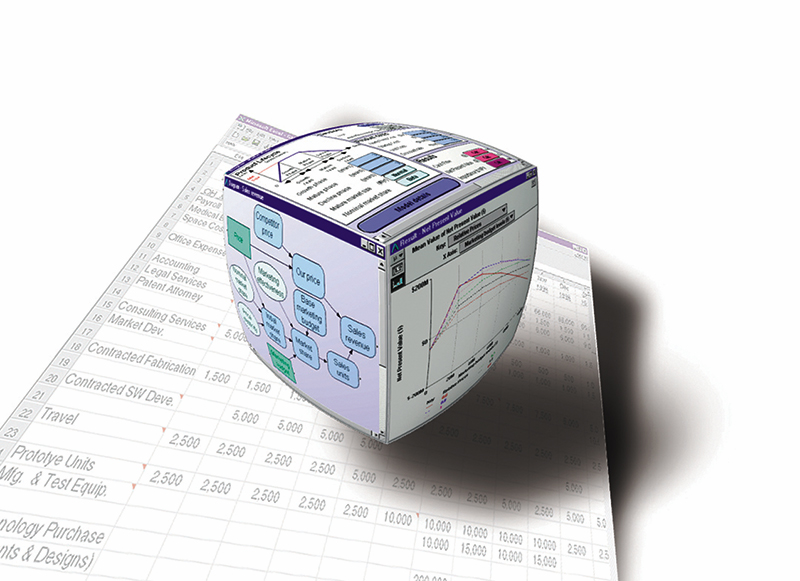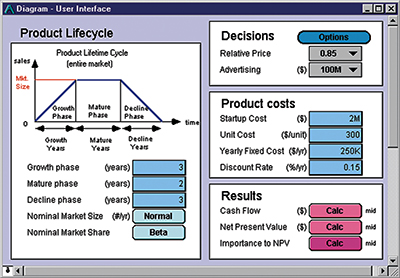
Quick Fix for Managing Risks
The critical components of a risk analysis software package intended for creating, analyzing, and communicating quantitative models have been integrated into a new system that is helping NASA's Kennedy Space Center manage and balance major tasks for Space Shuttle ground processing.
Under a Phase II Small Business Innovation Research (SBIR) contract, Kennedy and Lumina Decision Systems, Inc., of Los Gatos, California, jointly developed the Schedule and Cost Risk Analysis Modeling (SCRAM) system, based on a version of Lumina's flagship software product, Analytica.® Acclaimed as "the best single decision-analysis program yet produced" by MacWorld magazine, Analytica is a "visual" tool used in decision-making environments worldwide to build, revise, and present business models, minus the time-consuming difficulty commonly associated with spreadsheets. Lumina contends that Analytica helps users to visualize problems with a clarity and power "far beyond what is possible in a spreadsheet."
With Analytica as their platform, Kennedy and Lumina created the SCRAM system in response to NASA's need to identify the importance of major delays in Shuttle ground processing, a critical function in project management and process improvement. Landing-to-launch ground processing between Shuttle missions, also known as Shuttle turn-around, is a highly complex cycle that includes approximately 1,000 major processing tasks arranged around 24 subsystems. Roughly half of these tasks must be completed for every Shuttle turn-around, while the remaining tasks include periodic maintenance and inspection, and duties to handle special problems and mission-specific processing requirements.
With Kennedy being fully accountable for all aspects of Space Shuttle ground processingincluding the testing and checkout of the three major Shuttle components: the orbiter, the external tank, and the solid rocket boostersa new system was needed to replace its existing risk analysis tools, which provided constrained and limited modeling capabilities.
SCRAM methodologies were successfully implemented at Kennedy to improve the risk management processes, and NASA considered the new technology to be a significant improvement to the state-of-the-art in schedule and cost risk analysis, due to its ability to create and analyze realistic models of schedule variables (task lengths).
As part of the SCRAM development project, Lumina designed a version of Analytica called the Analytica Design Engine (ADE) that can be easily incorporated into larger software systems. ADE was commercialized and utilized in many other developments, including web-based decision support. For example, the design engine technology was used to power Ask Jeeves, Inc.'s Jeeves Purchase Advisor, an online assistance tool that helps consumers make informed purchase decisions that best suit their individual needs on products such as digital cameras or running shoes.
Resources for the Future, a nonprofit, non-advocacy research organization based in Washington, D.C., used the design engine technology to facilitate a U.S. Department of Energy assessment of the 1990 Clean Air Act Amendments. Decision Strategies, Inc., of Cumming, Georgia, also used ADE to develop interactive flow charts models in record time, saving a customer $15 million. Further applications include economic analysis of the cost-effectiveness of pollution-control technologies for fossil-fuel power plants, selecting a portfolio of research and development projects to maximize return and balance risk for aerospace and pharmaceutical companies, and forecasting needs for hospital beds and healthcare resources.
Analytica® is a registered trademark of Lumina Decision Systems, Inc.

Analytica® contains built-in functions that allow for the creation of a user control panel in minutes. Key inputs and outputs can be organized in one place so that users can quickly explore model behavior without navigating the model structure.

Analytica® is a visual software tool for creating, analyzing, and communicating quantitative business models.













